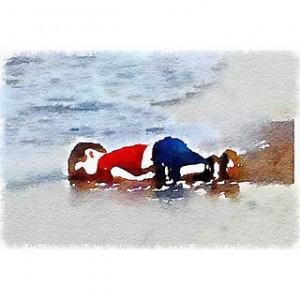In the era of Facebook, Twitter, and Instagram it seems as though images are constantly being uploaded, shared, and “liked.” While most publicly shared photos are flattering selfies or snapshots of kittens and babies, they occasionally showcase a darker subject matter—death.
Two weeks ago a photo went viral. In this photo, the lifeless body of a little Syrian boy, later identified as 3-year-old Aylan Kurdi, is pictured facedown in the sand of a Turkish beach, his small Velcro shoes still strapped to his feet. Aylan and his family had been traveling to Greece in order to flee the civil unrest in Turkey when the boat they were on capsized, killing several passengers including Aylan, his older brother, and their mother. Their bodies were later found and the infamous image of Aylan’s was captured by photographer Nilulfer Demir, so to “make his scream heard.”

Water color version of the now famous photo taken of Aylan Kurdi’s body. Source: https://www.flickr.com/photos/robertsharp
Although it has not been long, several news sites including The Wall Street Journal claim that this image will join a collection of photos, such as ones from the Great Depression and the Vietnam War, thought to have changed history. Both David Cameron and Manuel Valls, Prime Minsters of the United Kingdom and France respectively, have increased efforts to support and provide resources for refugees in response to this photo. Why is it though, that despite the countless photos of Syrian refugees that have been published, this one has made such an impact? If I had to guess, the answer revolves around death, especially that of a young child.
In an article from NPR, Los Angeles Times editor Kim Murphy admits that she is usually hesitant to publish photographs of corpses but her take on this photo was different. It is not violent or graphic, but rather heartbreaking in a way that makes people stop and think. I think the photo of Aylan poses a lot of questions about publishing images of death online and in the media. Is there a benefit to displaying such images or is it insensitive?
http://www.wsj.com/articles/image-of-syrian-boy-washed-up-on-beach-hits-hard-1441282847
http://www.npr.org/sections/thetwo-way/2015/09/03/437336063/image-of-dead-syrian-child-shakes-up-media-coverage-of-refugee-crisis
